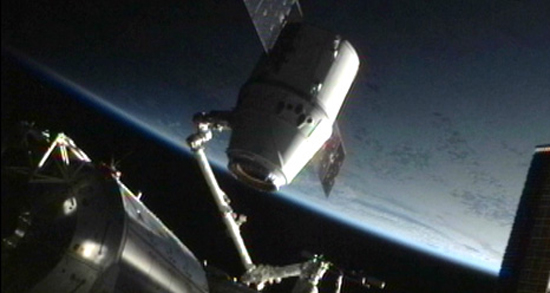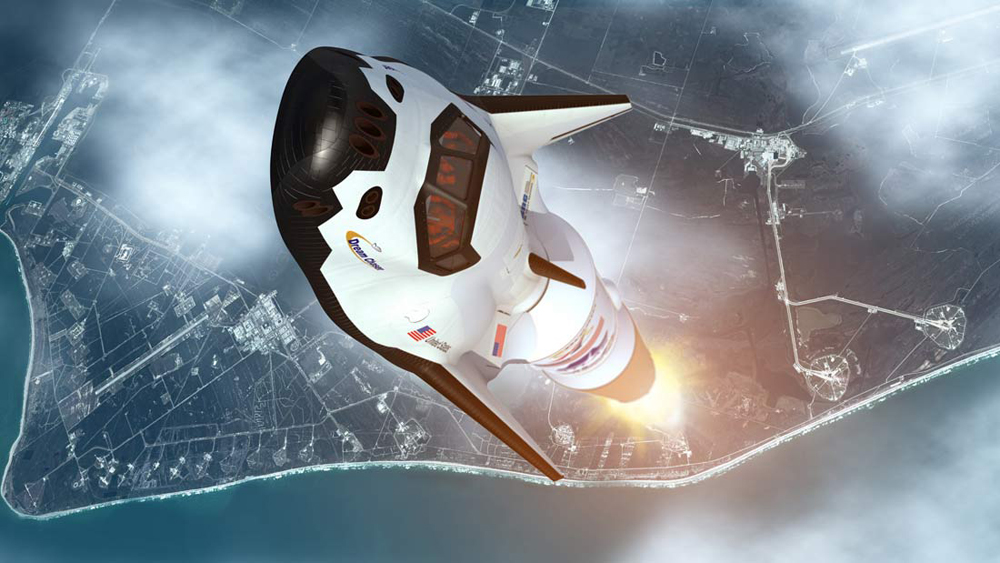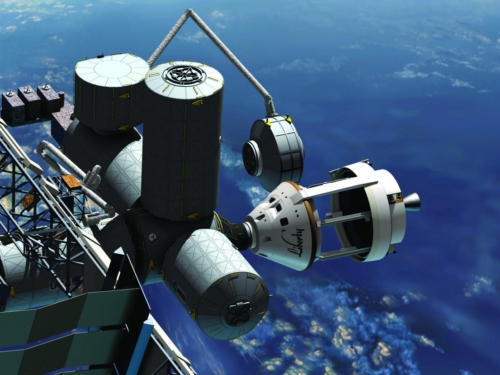NASA Awards $1.1 Billion in Support for 3 Private Space Taxis

NASA revealed new agreements with three private spaceflight companies today (Aug. 3) — deals that total $1.1 billion in funding support for new commercial spaceships to launch American astronauts into space.
The new deals represent the final round of NASA's Commercial Crew integrated Capability program (CCiCap), which aims to foster the design and development of new private spaceships to fill the current gap in U.S. human spaceflight capabilities.
The selected companies are:
- Sierra Nevada Corporation, headquartered in Louisville, Colo.
- Space Exploration Technologies (SpaceX), headquartered in Hawthorne, Calif.
- The Boeing Company, headquartered in Houston
As part of the new agreements, Sierra Nevada will receive $212.5 million, SpaceX will receive $440 million, and Boeing will receive $460 million. Boeing and SpaceX are developing private space capsules, with Sierra Nevada taking a different path with its winged Dream Chaser space plane design.
"The ultimate goal of our commercial crew program is to bring American space launches right back here to American soil," NASA Chief Charles Bolden said. [Now Boarding: The Top 10 Private Spaceships]
NASA retired its 30-year space shuttle program last year and is currently dependent on Russia's Soyuz spacecraft to ferry Americans to the International Space Station. The space agency's latest deal with Russia's Federal Space Agency carries a cost per seat of about $63 million. Once commercial spaceships are proven to be safe and reliable, NASA intends to purchase flights for astronauts to and from the space station.
"Our commercial crew and cargo efforts are based on a simple but powerful principle," Bolden said in a televised announcement. "By investing in American companies and American ingenuity we are spurring commercial companies to deliver more bang for the buck."
Breaking space news, the latest updates on rocket launches, skywatching events and more!
Between now and May 31, 2014, the companies funded under the CCiCap agreements will further develop and test their spacecraft designs. NASA expects that, following the successful completion of these milestones, manned demonstration flights to low-Earth orbit should launch by the middle of the decade.
"For 50 years American industry has helped NASA push boundaries enabling us to live, work and learn in the unique environment of microgravity and low Earth orbit," William Gerstenmaier, associate administrator for human exploration and operations at NASA Headquarters in Washington, D.C., said in a statement. "The benefits to humanity from these endeavors are incalculable. We're counting on the creativity of industry to provide the next generation of transportation to low Earth orbit and expand human presence, making space accessible and open for business." [Video: Private Space Taxis for Astronauts]
Diverse spaceship options
NASA officials said that the CCiCap selections fund a diverse group of commercial spacecraft designs, with each company taking a unique approach to its spacecraft design. Each of the three companies winning awards must pay their own share of spacecraft testing and development, space agency officials said.
"What that means to the tax payer is that NASA is not paying 100 percent of this development cost," said Ed Mango, manager of NASA's Commercial Crew Program. "They are also bringing money to the table."
Sierra Nevada's Dream Chaser space plane is a reusable winged spacecraft designed to launch seven astronauts into low-Earth orbit. The spacecraft will launch on an Atlas 5 rocket and lift off from Cape Canaveral, Fla., and is an evolution of a former NASA test vehicle known as the HL-20.
Dream Chaser will launch vertically and land on NASA's Shuttle Landing Facility runway, but can be retargeted to use airport runways in case of an emergency or different mission, said Phil McAlister, director of NASA's commercial spaceflight development. Sierra Nevada has a list of nine milestones to meet in order to receive all $212.5 million of its award. The company is aiming for its first manned test flight by 2016.
"We're very pleased today to receive the award from NASA as a recognition of our work. We think the whole program is a very successful public-private partnership," Mark Sirangelo, head of Sierra Nevada Corporation's Space Systems, told reporters after NASA's announcement.
New space capsules
SpaceX, meanwhile, is upgrading its unmanned Dragon space capsule to carry seven astronauts on round-trip flights to the International Space Station. Like the robotic Dragon capsule, which made its first trip to the station in May, the crewed Dragon will launch on SpaceX's own Falcon 9 rocket from the company's launch site at Cape Canaveral Air Force Station in Florida.
McAlister said SpaceX plans to land the Dragon capsule on land (the unmanned capsule that flew in May made an ocean splashdown), but the drop zone for the manned vehicle has not yet been decided. While SpaceX officials are targeting a crewed test flight of 2015 (a date based on optimum funding and successful testing), NASA is anticipating operational manned flights by 2017, McAlister added. [Inside SpaceX's Manned Dragon Capsule (Infographic)]
SpaceX is led by billionaire entrepreneur Elon Musk and already has a $1.6 billion contract with NASA to provide unmanned Dragon flights to the space station for cargo deliveries. To receive its full $440 million award, SpaceX will have to complete 14 different milestones, including two demonstration flights (one on Earth, the other in flight) to test the Dragon capsule's launch abort system.
Musk said called NASA's funding announcements today a "decisive milestone for human spaceflight." In a teleconference with reporters, he said SpaceX is still studying how the launch abort system tests will be performed, but they will be webcast and televised live.
"These are going to be some exciting tests," Musk said. "We anticipate some really exciting stuff in the American space program in the years ahead."
Boeing, meanwhile, is developing its own CST-100 space capsule, a seven-person vehicle that will launch into space atop an Atlas 5 rocket and make a land touchdown, McAlister said. The company is aiming to make its first crewed test flight in 2016.
"We come at this from a position of knowledge and experience," said John Mulholland, program manager of Boeing Commercial Programs within Boeing's space exploration division. "We have that experience we're able to use as we incoporate these approaches and streamline capabilities to make sure we're not sacrificing anything on crew safety or mission success. It give us a leg up on other competitors who don't have that experience base."
Boeing's CST-100 design won the biggest slice of CCiCap funding, but also has the most milestones to meet. In order to receive the full $460 million award, Boeing must complete 19 different milestones, McAlister said. The last milestone on that list is a complete critical design review of the entire CST-100 space capsule and Atlas 5 rocket launch system — a major feat, he added.
"We're really excited about today's announcement [and] certainly appreciate the confidence expressed by NASA in selecting us," said John Elbon, vice president and general manager of Boeing Space Exploration. "In 1916, Bill Boeing started the Boeing Company, and we've obviously grown into a large company since then, have learned a lot over that time, and are applying that knowledge to what we're doing on commercial crew. And it will be really sweet to celebrate the 100 year anniversary of the company with the first crewed flight of the CST-100."
Unfunded agreements possible
Seven different companies entered NASA's CCiCap competition. Three of them failed to meet NASA's basic requirements for consideration, while the fourth — Alliant Techsystems, or ATK, of Utah — came in just behind the top three selected, Gerstenmaier said.
ATK is the company that built the reusable solid rocket boosters for NASA's space shuttle launches. With the shuttle program retired, the company is developing a private rocket called Liberty in partnership with the European company EADS Astrium. The Liberty rocket and space capsule will use a five-segment solid rocket booster and European upper stage to launch a crewed space capsule into low-Earth orbit.
The capsule could ferry crews or cargo to the International Space Station, ATK officials have said. During NASA's previous commercial crew program round, ATK had an unfunded agreement with the space agency to use the agency's expertise while developing the Liberty rocket and spacecraft.
McAlister said NASA is open to possible unfunded agreements in the new commercial crew program round, but private space companies like ATK must make their own decisions on whether they want to enter such an arrangement.
Also not included in this latest round of funding is Blue Origin of Kent., Wash., a company owned by Amazon founder and billionaire Jeff Bezos that is developing private spacecraft for suborbital and orbital flights. The company did receive a NASA funding award in 2011 for its orbital crew vehicle, but wasn't among the seven vying for a spot in the CCiCap round, NASA officials said.
In addition to its work to spur private spaceflight, NASA is focusing on developing its own new heavy-lift rocket, called the Space Launch System, and a space capsule, called Orion, for exploration missions beyond low-Earth orbit. The agency has the goal of exploring a near-Earth asteroid by 2025 and traveling on to Mars by the 2030s.
SPACE.com Assistant Managing Editor Clara Moskowitz (@ClaraMoskowitz)and Staff Writer Denise Chow (@denisechow) contributed to this report. You can follow SPACE.com Managing Editor Tariq Malik on Twitter @tariqjmalikandSPACE.com on Twitter @Spacedotcom. We're also on Facebook and Google+.

Tariq is the award-winning Editor-in-Chief of Space.com and joined the team in 2001. He covers human spaceflight, as well as skywatching and entertainment. He became Space.com's Editor-in-Chief in 2019. Before joining Space.com, Tariq was a staff reporter for The Los Angeles Times covering education and city beats in La Habra, Fullerton and Huntington Beach. He's a recipient of the 2022 Harry Kolcum Award for excellence in space reporting and the 2025 Space Pioneer Award from the National Space Society. He is an Eagle Scout and Space Camp alum with journalism degrees from the USC and NYU. You can find Tariq at Space.com and as the co-host to the This Week In Space podcast on the TWiT network. To see his latest project, you can follow Tariq on Twitter @tariqjmalik.


